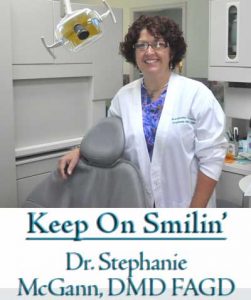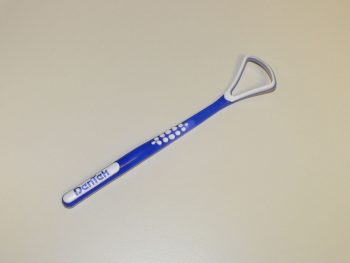By Dr. Stephanie McGann, DMD FAGD, Columnist, The Times
 If you never heard of tongue scraping – you are not alone. While it’s been a standard go-to therapy in bad-breath treatment for years, most of us never really paid a lot of attention to our tongues. So let me explain what it’s all about.
If you never heard of tongue scraping – you are not alone. While it’s been a standard go-to therapy in bad-breath treatment for years, most of us never really paid a lot of attention to our tongues. So let me explain what it’s all about.
Just imagine that cold winter day (the one we are all dreading) … as you stand at the door, ready to brave the cold. You’re layered-up with three shirts and a sweatshirt, your heavy winter coat, and two layers of socks underneath your waterproof winter boots. Then you’ve got those awesome jeans with the flannel on the inside, your comfy hat, scarf, and gloves. You’re set! But wait. As you step toward the door, you suddenly realize you have an itch … and it’s deep down … buried beneath all those layers. And, try as you may, every attempt to reach that spot fails. Defeated, you realize the only relief you’re ever gonna’ get is to remove each one of those layers.
Where am I going with this?
The Tongue – this is a dental article, after all. Because whether you know it or not, like you in the wintertime, your tongue is also “all covered up” – buried beneath layers of old mucus, bacteria, fungi, and food residue that can inhibit your ability to taste, let alone cause your tongue to appear various shades of yellow, white, brown, or green! Smokers have it even worse as tar and ash also leave a residue on the tongue. Remove the gunk, and your food will once again directly interact with those taste buds, and return to its happy pink color. So how does one do that? With a simple process of daily tongue scraping.
WHAT is a tongue scraper? A tongue scraper is a U-shaped device designed to “scrape” the top layer of scum from your tongue. They have been in use since ancient times, and have been made of everything from wood to whalebone. Nowadays, they are made of more hygienic material, and come in a variety of shapes, sizes, designs and colors. I prefer to recommend the plastic ones with a handle they are the easiest to use. Avoid any scrapers that are made of metal, while they work fine, someone who scrapes to aggressively can cause damage with a metal scraper.
WHY use a tongue scraper? The residue on your tongue includes things like the cavity-inducing Streptococcus mutans bacterium, fungi, rotting food (that’s not good), and what’s referred to as “volatile sulfur compounds.” In other words, sulfur – that “rotting egg smell.” Talk about ew! So, as you can see, there are several reasons why you’d want to get rid of this gunk in your mouth. Let’s tackle them one by one:
- Reduce bad breath: ‘nuff said!
- Reduce your risk of periodontal disease and cavities: Bad bacteria contribute to plaque and tartar on teeth, making them more susceptible to cavities. Bacteria build-up can also lead to inflammation of gum tissue (gingivitis). If left untreated, gingivitis can lead to periodontal disease, which means a more expensive dental visit (plus other unwanted consequences!).
- Make room for good bacteria:When good bacteria are overwhelmed by bad bacteria the normal balance is upset.
- Prevent heart disease? While the debate is still up in the air, some studies suggest there could be a correlation between gum disease and heart disease, stroke and other significant medical issues.
HOW does one use a tongue scraper? In general, make sure to rinse your tongue scraper before and after use. Use once a day. Apply the tongue scraper to the back of your tongue and drag it forward. Then, rinse and repeat. Make sure to get the sides of your tongue as well, not just the center! Make sure not to press too hard or you can cause yourself to bleed. And, if you’re wondering if you should scrape your tongue while recovering from a dental procedure, that’s a good question … ask your dentist for the best advice particular to your situation. Tongue scrapers are relatively inexpensive, and can also be found at any local drugstore. It doesn’t matter the material, color, or brand – just find the one you like and get scraping!
Dr. Stephanie McGann, who has more than two decades of dental practice experience, is a resident of the Unionville area and along with her partner, Dr. Marie Scott, practice at The Brandywine Smile Center, a family-friendly dental practice in Concordville. Dr. McGann also owns a practice in Valley Township, Rainbow Valley Dental. She is a past President of the Chester/Delaware Dental Society and she is a Fellow of the Academy of General Dentistry.





